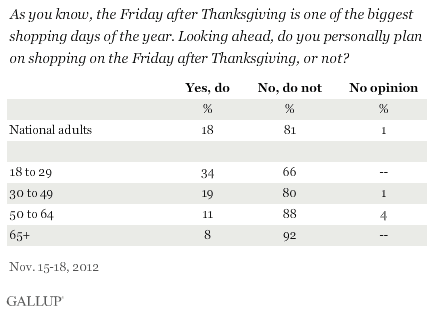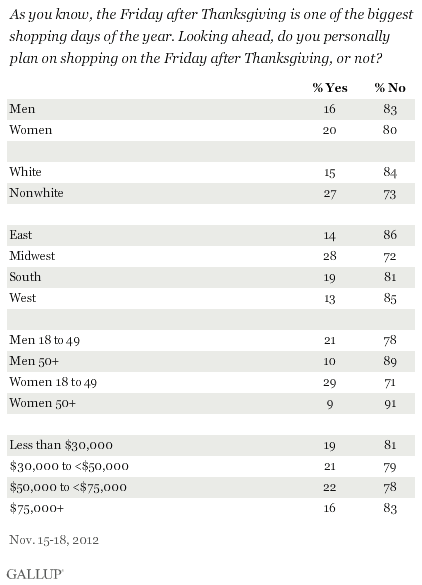PRINCETON, NJ -- Despite all the attention focused on "Black Friday" shopping, fewer than one in five Americans say they plan to shop on the day after Thanksgiving this year. But more than a third of those aged 18 to 29 report they will be taking advantage of the sales and price discounts. Black Friday shopping intentions drop off as age increases, falling to 8% for those 65 and older.

The Nov. 15-18 Gallup poll marks the first time Gallup has asked Americans if they plan to shop on Black Friday, so it is not possible to know if the 18% who plan to do so is typical of Black Friday shopping in the past. Nor is it known how the 18% estimate compares with shopping intentions on other days of the year. The post-Thanksgiving shopping experience now begins on Thanksgiving Day itself in many instances, and extends through Saturday and Sunday of the weekend, so it is virtually certain that many more than 18% of Americans will end up shopping at some point over the Thursday through Sunday period -- either in person or online.
In addition to the youthful skew of the Black Friday shopping population, Americans living in the Midwest and nonwhites are significantly more likely than average to say they will shop on Black Friday.
Women are only slightly more likely than men to say they will be shopping on Friday, while there is little difference in self-reported shopping intentions across income categories.

Most Black Friday Shoppers Are After Cheap Prices
The relatively small percentage of Americans who say they will shop on Black Friday nearly unanimously say cheap prices and sales are an important reason for their shopping. Shoppers are less likely to say that getting holiday shopping done well before Christmas is an important reason for their behavior, and still fewer say they will shop on Black Friday because they have the day off, because there is a better selection of merchandise available, or because it's a family holiday tradition.
![(Asked of those who plan to shop the Friday after Thanksgiving) Please say if each of the following is or is not an important reason why you will be shopping on the Friday after Thanksgiving? How about -- [RANDOM ORDER]? November 2012 results](http://content.gallup.com/origin/gallupinc/GallupSpaces/Production/Cms/POLL/zh7bzyyb6uwvx_9oefjulw.gif)
Implications
While the frenzied advertising and extreme focus on Black Friday shopping might lead one to believe that the entire country will be out shopping on the day after Thanksgiving, it instead appears to be a behavior confined to well less than half of American adults. Most Americans apparently will find ways other than shopping to spend the day after Thanksgiving -- perhaps working, spending time with family, or relaxing around the house.
Black Friday shopping intentions are more common among those who are young or nonwhite, or who live in the Midwest. The most important motivation for Black Friday shopping appears to be straightforward -- shoppers believe they will be able to take advantage of cheap prices and sales.
Survey Methods
Results for this Gallup poll are based on telephone interviews conducted Nov. 15-18, 2012, with a random sample of 1,015 adults, aged 18 and older, living in all 50 U.S. states and the District of Columbia.
For results based on the total sample of national adults, one can say with 95% confidence that the maximum margin of sampling error is ±3 percentage points.
Interviews are conducted with respondents on landline telephones and cellular phones, with interviews conducted in Spanish for respondents who are primarily Spanish-speaking. Each sample includes a minimum quota of 400 cellphone respondents and 600 landline respondents per 1,000 national adults, with additional minimum quotas among landline respondents by region. Landline telephone numbers are chosen at random among listed telephone numbers. Cellphone numbers are selected using random-digit-dial methods. Landline respondents are chosen at random within each household on the basis of which member had the most recent birthday.
Samples are weighted by gender, age, race, Hispanic ethnicity, education, region, adults in the household, population density, and phone status (cellphone only/landline only/both, cellphone mostly, and having an unlisted landline number). Demographic weighting targets are based on the March 2011 Current Population Survey figures for the aged 18 and older population living in U.S. All reported margins of sampling error include the computed design effects for weighting.
In addition to sampling error, question wording and practical difficulties in conducting surveys can introduce error or bias into the findings of public opinion polls.
View methodology, full question results, and trend data.
For more details on Gallup's polling methodology, visit www.gallup.com.
